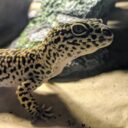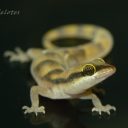This is the fourth article in this series and part 2 of leopard geckos.
Gecko Time readers might recognize this enclosure from a previous leopard gecko bioactive article. What happened? Superworms!
Zophobas morio overpopulated and became a smelly nuisance, and the worms escaped through gaps around the door. I tore down the enclosures and went back to the drawing board after I found adult beetles wandering my home.
This update contains several improvements.
Vivarium Construction
Enclosure and Hardscape
A 20-gallon long is the U.S. recommendation for a single adult leopard gecko (30” L x 12” W x 12” H). I use stackable, front-opening display compartments (24” D x 15.5” W x 11” H). Any less space is too cramped for an adult to live decades, and more space is always appreciated by this active species.
When dealing with burrowing animals, install hardscape features onto the cage floor prior to adding substrate. I used lightweight, prefabricated hides. One cave was positioned over the heat and another on the cool end. The humid hide was placed near the light fixture, where it would stay warm. Moistened Zoo Med Excavator Clay was used to make cave entrances and wall off the custodian refuge.
You also can construct your own hides using rocks, wood, or clay. If stacking items, secure them with aquarium silicone; drilled holes with screws or zip ties are needed for heavier pieces. Full backgrounds can be bought or made, if your space allows.
Substrate and Plants
Desert Base Substrate
This recipe will hold burrows when damp and dries to a crust on top.
- 4 parts natural sand
Sand with variable grains preferable; play sand okay - 2 parts ground coconut fiber
Any reptile-safe, fine coir - 1 part worm castings or leaf mould/compost
Avoid guano/manure-heavy composts - 1 part Zoo Med Excavator Clay
- 1 part topsoil
Plain soil without perlite or fertilizers
I doubled the recipe in cups to make batches over a gallon and added the following to each batch:
- ¼ teaspoon sulfur powder
Alternative: organic soil acidifier - Organic fertilizer
Use ⅓ label strength - ¼ teaspoon bioactivity booster
Alternative: organic compost starter
The sand was washed prior to use, so the substrate mix was damp. This starts the lower layers humid to maintain bioactivity and allows the top to form a crust. This desert base is used everywhere except plant or custodian refuge areas. Most areas should be at least 3 inches deep, but if you are using floor heat, you can leave spots shallow or bare.
Plant and Custodian Refuge
I selected a shade-tolerant dwarf Sansevieria, which was bare rooted and soaked prior to use. Plant lighting will support more species—cacti, succulents, or grasses. Choose plants that do not have dangerous spines/sap and will remain a reasonable size.
For planting substrate I mixed equal parts desert substrate and forest vivarium mix. Research your plant species and amend your substrate appropriately. If you decide to use a potting mix that includes perlite, cover it with stones to avoid having perlite within reach of your gecko. After planting, I watered the plant with half-strength fertilizer.
Colonizing desert enclosures can be difficult for custodian invertebrates, and one technique that works wonders is the custodian refuge. A custodian refuge is an area that remains dark and humid, usually beneath a dish, rock, or piece of wood. It gives invertebrates somewhere to retreat to during the day and ensures they don’t become dehydrated. This area can also have substrate with more aeration and organic matter, preferred by many custodian species. I filled the entire plant corner with desert-forest mix, as the area would be doubling as a refuge.
Rocky Top Layer
I arranged large pebbles and small pieces of slate, then pressed an equal mix of desert substrate and medium gravel into the entire surface. Everything was given a very good misting to settle it.
The custodian refuge was completed with live oak leaf litter and cork bark. Covering humid spots gives the custodians hiding places and slows the release of moisture into the air.
Heat, Light, and Humidity
My enclosure had heat tape under the back third of the floor and a small light fixture that generated overhead heat during the day. The bare floor in the warm cave provided direct access to floor heat controlled by a thermostat. You can experiment with substrate depth in your own enclosure or switch to overhead, lightless heat sources if floor heating is not feasible.
I installed a UVB100 13W bulb in the light fixture. While it provides intense rays directly underneath, my geckos always bask where the UV index is lower.
No plant lighting was included. Instead, the Sansevieria was placed at the front to receive ambient room light. Light fixtures generate heat, and any additional lights increase the temperature in these enclosures to an unacceptable level. If your fixtures are outside your cage, this is less of a concern.
Custodians
I no longer recommend superworms for leopard gecko enclosures; the humidity required for these geckos allows the insects to breed too rapidly. Also avoid other types of beetles that are prolific breeders, like lesser mealworms (buffalo beetles). I seeded these enclosures with three types of custodians:
- Armadillidium vulgare
Common pill bugs - Folsomia candida
White springtails - Psocids
Booklice
Booklice, with a similar niche to springtails, have proven to be champions of desert survival. Be aware they can have population booms if provided with too much food and moisture. If you crave more variety, look into death-feigning (ironclad) beetles, which don’t readily breed.
Final Touches
The enclosure dried for a week and was completed with magnetic ledges, which provide gecko perches in the absence of a full background. The humid hide was filled with ground coconut fiber, which I keep damp and change occasionally.
After Care
Cycling Period
A desert system is not likely to see a mold bloom, but a cycling period allows your plants to root. They will be easily disturbed in the first months.
Animal Introduction
Your gecko may display agitated behavior when first moved to a new enclosure, but don’t be tempted to blame bioactive! It is simply a reaction to being in an unfamiliar territory. Be prepared for a few weeks of strange behavior.
Because change can be stressful, ensure your animal is healthy and a good weight before moving them. Fecal screenings prior to the move will ensure they do not introduce any parasites into the bioactive system.
Continuing Maintenance
Desert enclosures require replenishing organic matter and trimming plants. Periodically remove urates or mix them into the soil near plants. They are not eaten by custodian species, and without wind and rain action to break them down, they persist. Occasional mistings will keep down dust and resettle the substrate crust, and limited watering will keep the sublayers damp.
Final Thoughts
Whatever your species, keeping their wild habitat and ideal conditions in mind will keep them happy, and remembering the components necessary for bioactivity will keep them healthy. I encourage you to find as many planning resources as possible, especially scientific studies. There are forums and groups devoted to various species and bioactive enclosures, so reach out to other hobbyists for construction techniques.
Most of all, do what is comfortable for you! What’s important is that you provide a safe and stimulating environment for your animal that means their needs, not someone else’s personal preferences.
Remember: There isn’t one right way to keep a gecko.
Find more on YouTube
This article has a YouTube video series that follows along with the construction and provides more details.
Resources
- Bokhari, Sheriyar. “Bioactive Setup for Desertic Reptiles.” Animalias (forum), reposted by littlereptile, September 27, 2015.
http://animalias.boards.net/thread/50/bioactive-dry-set-ups - De Vosjoli, Philippe. 1996. Design and Maintenance of Desert Vivaria. Santee: Advanced Vivarium Systems, Inc.
- Purser, Philip. 2007. Natural Terrariums. Neptune City: TFH Publications.
———. “How to Create the Perfect Desert Vivarium.” Reptiles. Accessed July 18, 2019.
http://www.reptilesmagazine.com/How-To-Create-The-Perfect-Desert-Terrarium/
- Rolfe, Gary. 2017. “How to Create an Arid Bioactive Vivarium.” Northampton Reptile Centre (blog), December 7, 2017.
https://www.reptilecentre.com/blog/2017/12/how-to-create-an-arid-bioactive-vivarium/ - Searcey, Rex Lee. “Natural Vivarium Substrate Recipes.” Reptiles. Accessed July 18, 2019.
http://www.reptilesmagazine.com/Natural-Vivarium-Substrate-Recipes/



